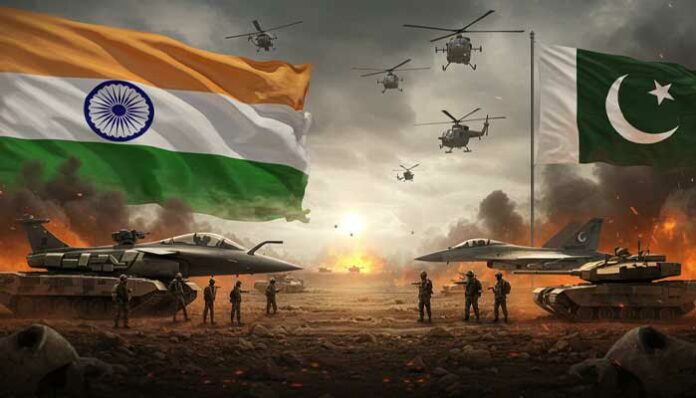In 2025, India ranked 4th in the world for military power, while Pakistan was 12th. This shows India has a stronger military, but Pakistan still has a strong defense.
The atmosphere at the border is becoming more tense with each passing day. Both Pakistan and India seem focused on causing harm to each other in small but steady ways, as reported by The News. The situation continues to escalate as both nations build up their military power in preparation for what comes next.
A History Marked by Ongoing Struggles
It’s interesting to compare the military power of these two nuclear countries, especially since they’ve fought four major wars since 1947 and have been involved in many conflicts, mostly over the Kashmir issue.
The military power of Pakistan and India is constantly evolving. Let’s take a look at the current weapons held by both countries to understand their defense capabilities better. As tensions rise, their stockpiles continue to grow, shaping the future of regional security.
Ranking the World’s Military Forces
The global ranking of military power reveals interesting insights. According to “Global Firepower,” a popular website that has been ranking the military power of 145 countries since 2006, Pakistan holds the 12th spot in 2025. Meanwhile, India is ranked 4th, behind the United States, Russia, and China, as one of the world’s most powerful militaries. The ongoing shift in military power continues to shape global security.
In its latest report, the well-known Stockholm International Peace Research Institute (SIPRI) shows that India is the fifth-biggest spender on its military, with a budget of $86 billion. In contrast, Pakistan is ranked 29th, spending just $10 billion—almost nine times less than India.
When it comes to military spending, the latest figures from SIPRI reveal a clear picture of global priorities. The United States leads by far, with a budget of $997 billion, followed by China at $314 billion and Russia at $149 billion. Other major spenders include Germany ($88 billion), India ($86 billion), and the UK ($82 billion). Saudi Arabia, Ukraine, France, and Japan round out the top 10, with military budgets of $80 billion, $65 billion, $65 billion, and $55 billion respectively.
In terms of military power, the “Global Firepower Index” has shared the latest details. The following statistics highlight the strengths of these two nuclear-armed neighboring countries:
Overcoming Challenges, Seizing Opportunities: The Path Forward for Pakistan
Pakistan’s defense forces are robust, with 654,000 active soldiers, 500,000 paramilitary members, and 550,000 reserves. The air force operates 1,399 aircraft, including 328 fighter jets and 373 helicopters. The army is equipped with 2,627 tanks, 17,516 armored vehicles, and over 3,200 artillery units. Additionally, there are 600 mobile rocket launchers. The navy includes 121 ships, with 8 submarines, 9 frigates, and 69 patrol boats, though it has no aircraft carriers. Pakistan has 116 airports, 60 merchant ships, and 3 major ports.
Facing Struggles, Embracing Growth: Shaping a New Tomorrow for India
India’s defense system is large and well-prepared. It has over 14.5 lakh active soldiers, 25 lakh paramilitary personnel, and 11 lakh reserve troops. The air force includes more than 2,200 aircraft, with over 500 fighter jets and nearly 900 helicopters. On land, the army uses thousands of tanks and around 1.5 lakh armored vehicles, along with rocket launchers and artillery. The Navy operates nearly 300 ships, including submarines, frigates, patrol boats, and two aircraft carriers. This is supported by 311 airports, 56 ports, and around 1,860 merchant ships that aid in transport and trade.
In terms of nuclear capabilities, India and Pakistan remain closely matched. According to the June 2024 report by the Stockholm International Peace Research Institute, India is estimated to have 172 nuclear warheads, slightly surpassing Pakistan’s count of 170. This comparison highlights the ongoing balance of power in the region.
For the first time in 25 years, India’s nuclear arsenal now exceeds that of Pakistan, marking a significant shift in the balance of military power.
In the past, reports from Western groups like SIPRI and the International Panel on Fissile Materials (IPFM) have shown that Pakistan has usually had a small lead over India in the number of nuclear weapons, with a difference of about five to ten warheads.
Growth of Nuclear Power and Its Advancements
According to SIPRI, India’s nuclear weapons can be launched using fighter jets, missiles stationed on land, and missiles fired from submarines. On the other hand, Pakistan’s nuclear weapons are delivered through aircraft, missiles fired from the ground, and cruise missiles that can be launched from the sea.
In a report released less than a year ago, the Stockholm International Peace Research Institute revealed that Pakistan had a limited number of nuclear gravity bombs. The country was also advancing its cruise missile capabilities, notably with the development of the Ra’ad (Hatf-8), which improved the Air Force’s ability to carry out nuclear strikes over ranges of 350 to 600 km. This development marks a significant step in enhancing Pakistan’s military capabilities.
Approaches to Strengthening Security in the Region
Pakistan’s Ability to Use Nuclear Weapons Through Its Air Force
Pakistan’s air force operates aircraft such as the Mirage-III, Mirage-V, F-16, and JF-17, which many experts believe can deliver nuclear payloads. However, officials have not clarified the exact role these planes would play in nuclear operations, and they have withheld further details.
India’s Growing Nuclear Power on Land, in the Air, and at Sea
India is actively developing its nuclear triad, which will involve aircraft, land-based missiles, and nuclear-capable submarines. This strategic development aims to strengthen the country’s defense capabilities from both the air, land, and sea.
India’s Changing Approach to Nuclear Readiness
As per SIPRI, India has traditionally kept its nuclear warheads and delivery systems apart during peacetime. However, recent steps indicate a shift in this practice, with certain warheads now being paired with launchers even during times of peace. This marks a notable change in India’s approach.
The Institute reports that India maintains an air-based component of its nuclear forces. This segment relies on fighter aircraft such as the Mirage 2000H, Jaguar IS, and Rafale, which many analysts believe can carry out nuclear missions. Analysts estimate that these jets are assigned around 48 gravity-based nuclear bombs. This setup plays a key role in strengthening India’s overall nuclear deterrence strategy.
India is steadily building up its missile strength. New land-based missiles like the Agni-P are nearly ready, and work is underway on submarines that can launch nuclear missiles, boosting second-strike power. With future missiles like Agni-VI and Surya, India could soon reach targets anywhere in the world. These moves show India’s focus on stronger and wider nuclear defense.
Worldwide Trends in Nuclear Strength
According to the SIPRI report, experts estimate that global nuclear arsenals include 12,121 warheads. Out of these, militaries have stored 9,585 in stockpiles, ready for potential use. Russia and the US, and now China, maintain around 2,100 warheads on high alert. Nine nuclear-capable countries—the US, Russia, UK, France, China, India, Pakistan, North Korea, and Israel—are actively modernizing their weapons and deploying new systems to deliver nuclear payloads.
How Military Leaders See the Future of Conflict
On Shahzeb Khanzada’s show on Geo News, General (retd) Nasir Janjua, who served as Pakistan’s National Security Adviser from October 2015 to June 2018, shared his views: “The possibility of war between Pakistan and India is no longer on the table. If that were to change, it would result in complete devastation. The ability to engage in traditional warfare is closely linked with nuclear power, and Pakistan is fully capable of protecting itself. No matter what actions India takes, we will respond appropriately. Instead of blaming Pakistan for its own shortcomings, India should focus on holding accountable those responsible for the Pulwama attack.
The Origins of the Conflict: Political and Social Factors at Play
This conflict stems from more than just political errors; it reflects opposing views and long-standing social structures that have shaped the region’s history. Lieutenant-General Ghulam Mustafa, a seasoned military leader who has commanded multiple strategic units, including a Corps and the Army Strategic Forces Command, shared his thoughts: “The caste system has profoundly shaped Indian society. In this context, Hinduism does not function merely as a religion; it enforces a social order that creates rigid divisions. The upper castes have denied lower castes, especially Dalits or ‘untouchables’—basic dignity, rights, and the opportunity to progress in society.
The Rise of Hindu Nationalism and Its Effects on Society
In today’s world, Hindu nationalism is attempting to reshape India’s identity along religious lines. At the highest level of this social structure were the Brahmins, who held not only religious power but also shaped societal norms and influenced cultural practices across the Indian subcontinent. This shift is not merely political; it’s a fundamental effort to alter the very fabric of society. He noted that Kashmir is the focal point of this ideological struggle.

